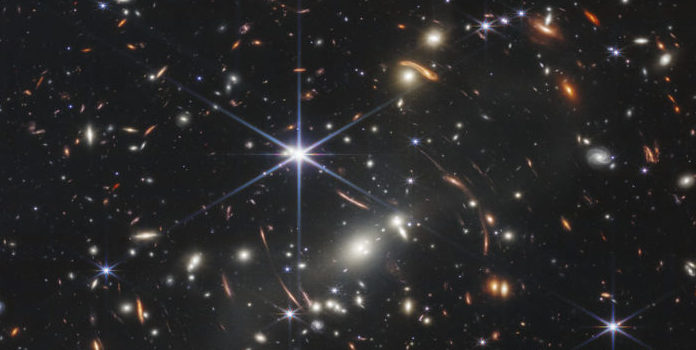(Headline USA) Our view of the universe just expanded: The first image from NASA’s new space telescope unveiled Monday is brimming with galaxies and offers the deepest look of the cosmos ever captured.
The first image from the $10 billion James Webb Space Telescope is the farthest humanity has ever seen in both time and distance, closer to the dawn of time and the edge of the universe. That image will be followed Tuesday by the release of four more galactic beauty shots from the telescope’s initial outward gazes.
The “deep field” image released is filled with lots of stars, with massive galaxies in the foreground and faint and extremely distant galaxies peeking through here and there. Part of the image is light from not too long after the Big Bang, which was 13.8 billion years ago.
The busy image with hundreds of specks, streaks, spirals and swirls of white, yellow, orange and red is only “one little speck of the universe,” NASA Administrator Bill Nelson said.
“What we saw today is the early universe,” Harvard astronomer Dimitar Sasselov said in a phone interview after the reveal.
Sasselov said he and his colleague Charles Alcock first thought “we’ve seen this before.” Then they looked closer at the image and pronounced the result not only beautiful but “worth all that waiting” for the much-delayed project.
The world’s biggest and most powerful space telescope rocketed away last December from French Guiana in South America. It reached its lookout point 1 million miles from Earth in January. Then the lengthy process began to align the mirrors, get the infrared detectors cold enough to operate and calibrate the science instruments, all protected by a sunshade the size of a tennis court that keeps the telescope cool.
The plan is to use the telescope to peer back so far that scientists will get a glimpse of the early days of the universe about 13.7 billion years ago and zoom in on closer cosmic objects, even our own solar system, with sharper focus.
How far back past 13 billion years did that first image look? NASA didn’t provide any estimate Monday. Outside scientists said those calculations will take time, but they are fairly certain somewhere in the busy image is a galaxy older than humanity has ever seen, probably back to 500 million or 600 million years after the Big Bang.
“It takes a little bit of time to dig out those galaxies,” University of California, Santa Cruz, astrophysicist Garth Illingworth said. “It’s the things you almost can’t see here, the tiniest little red dots.”
“This is absolutely spectacular, absolutely amazing,” he added. “This is everything we’ve dreamed of in a telescope like this.”
Webb is considered the successor to the highly successful, but aging Hubble Space Telescope. Hubble has stared as far back as 13.4 billion years. It found the light wave signature of an extremely bright galaxy in 2016. Astronomers measure how far back they look in light-years with one light-year being 5.8 trillion miles.
“Webb can see backwards in time to just after the Big Bang by looking for galaxies that are so far away that the light has taken many billions of years to get from those galaxies to our telescopes,” said Jonathan Gardner, Webb’s deputy project scientist said during a June media briefing.
The deepest view of the cosmos “is not a record that will stand for very long,” project scientist Klaus Pontoppidan said during the briefing, since scientists are expected to use the Webb telescope to go even deeper.
At 21 feet, Webb’s gold-plated, flower-shaped mirror is the biggest and most sensitive ever sent into space. It’s comprised of 18 segments, one of which was smacked by a bigger than anticipated micrometeoroid in May. Four previous micrometeoroid strikes to the mirror were smaller. Despite the impacts, the telescope has continued to exceed mission requirements, with barely any data loss, according to NASA.
NASA is collaborating on Webb with the European and Canadian space agencies.
“I’m now really excited as this dramatic progress augurs well for reaching the ultimate prize for many astronomers like myself: pinpointing “Cosmic Dawn” — the moment when the universe was first bathed in starlight,” Richard Ellis, professor of astrophysics at University College London, said by email.
Adapted from reporting by the Associated Press

